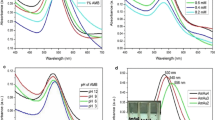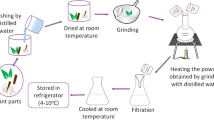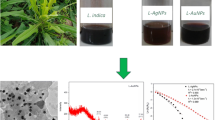Abstract
Industrial waste effluents such as p-nitrophenol and heavy metals are considered as the main cause of water contamination. These contaminants lead to severe health hazardous effects to living organisms as well as to environment. For this purpose, the green synthesis of metallic nanoparticles has gotten more attention as a result of the rising need for non-toxic, rapid, simple, and environmentally compatible synthetic routes. In the present research, the basic objective is to detect the presence of these contaminants in water and to degrade the p-nitrophenol into a harmless by-product. The objectives were carried out using a a clean and sustainable method for making biogenic gold nanoparticles (AuNPs) from the stem extract of N. leucophylla. The electron microscopic and spectroscopic studies confirmed the formation of monodisperse and stable nanoparticles having size of 15–20 nm and a sharp absorption band at 548 nm. Further, the catalytic efficacy of the prepared nanoparticles was investigated towards the reduction of p-nitrophenol and for the reduction of heavy metal. The reduction of p-nitrophenol (100% conversion) in alkaline medium was observed using AuNPs as catalyst. The synthesized NPs showed a selective and sensitive colorimetric detection of Cr2+. The limit of detection for Cr2+ was found to be 2.56 µM. This report suggests the potential of novel gold nanoparticles of N. leucophylla towards the water remediation.
Graphical abstract












Similar content being viewed by others
References
Das A, Dey A (2020) P-Nitrophenol-bioremediation using potent Pseudomonas strain from the textile dye industry effluent. J Environ Chem Eng 8:103830. https://doi.org/10.1016/j.jece.2020.103830
Hanne LF, Kirk LL, Appel SM et al (1993) Degradation and induction specificity in actinomycetes that degrade p- nitrophenol. Appl Environ Microbiol 59:3505–3508. https://doi.org/10.1128/aem.59.10.3505-3508.1993
Sawal M (1986) General standards for discharge of environmental pollutants. Environ Rules 2:545–560
Liu Y, Luan J, Zhang C et al (2019) The adsorption behavior of multiple contaminants like heavy metal ions and p-nitrophenol on organic-modified montmorillonite. Environ Sci Pollut Res 26:10387–10397. https://doi.org/10.1007/s11356-019-04459-w
Singh J, Mehta A, Rawat M, Basu S (2018) Green synthesis of silver nanoparticles using sun dried tulsi leaves and its catalytic application for 4-Nitrophenol reduction. J Environ Chem Eng 6:1468–1474. https://doi.org/10.1016/j.jece.2018.01.054
Thompson DT (2007) Using gold nanoparticles for catalysis. Nano Today 2:40–43. https://doi.org/10.1016/S1748-0132(07)70116-0
Corma A, Garci H (2008) Supported gold nanoparticles as catalysts for organic reactions. Chem Soc Rev 37:2096–2126. https://doi.org/10.1039/b707314n
Stratakis M, Garcia H (2012) Catalysis by supported gold nanoparticles: beyond aerobic oxidative processes. Chem Rev 112:4469–4506. https://doi.org/10.1021/cr3000785
Szűcsab R, Balogh-Weisercd D, Sánta-Bellc E et al (2019) Green synthesis and in situ immobilization of gold nanoparticles and their application for the reduction of p-nitrophenol in continuous-flow mode. RSC Adv 9:9193
Suchomel P, Kvitek L, Prucek R et al (2018) Simple size-controlled synthesis of Au nanoparticles and their size-dependent catalytic activity. Sci Rep 8:1–11. https://doi.org/10.1038/s41598-018-22976-5
Lin C, Tao K, Hua D et al (2013) Size effect of gold nanoparticles in catalytic reduction of p-nitrophenol with NaBH4. Molecules 18:12609–12620. https://doi.org/10.3390/molecules181012609
Vasam M, Punagoti RA, Mourya R (2021) Biomedical applications of gold nanoparticles. Nanotechnol Life Sci 15:41–59. https://doi.org/10.1007/978-3-030-84262-8_2
Lopes-Nunes J, Agonia AS, Rosado T et al (2021) Aptamer-functionalized gold nanoparticles for drug delivery to gynecological carcinoma cells. Cancers (Basel) 13:1–16
Yafout M, Ousaid A, Khayati Y, El Otmani IS (2021) Gold nanoparticles as a drug delivery system for standard chemotherapeutics: a new lead for targeted pharmacological cancer treatments. Sci African 11:e00685. https://doi.org/10.1016/j.sciaf.2020.e00685
Mulikova T, Abduraimova A, Molkenova A et al (2021) Mesoporous silica decorated with gold nanoparticles as a promising nanoprobe for effective CT X-ray attenuation and potential drug delivery. Nano-Struct Nano-Obj 26:100712
Muddapur UM, Alshehri S, Ghoneim MM et al (2022) Plant-based synthesis of gold nanoparticles and theranosticapplications: a review. Molecules 27:1391
Liu XY, Wang JQ, Ashby CR et al (2021) Gold nanoparticles: synthesis, physiochemical properties and therapeutic applications in cancer. Drug Discov Today 26:1284–1292. https://doi.org/10.1016/j.drudis.2021.01.030
Ielo L, Rando G, Giacobello F et al (2021) Synthesis, chemical-physical characterization, and biomedical applications of functional gold nanoparticles: a review. Molecules 26:5823
Tyagi H, Kushwaha A, Kumar A, Aslam M (2016) A facile pH controlled citrate-based reduction method for gold nanoparticle synthesis at room temperature. Nanoscale Res Lett 11:1–11. https://doi.org/10.1186/s11671-016-1576-5
Aryal S, Remant BKC, Dharmaraj N et al (2006) Spectroscopic identification of SAu interaction in cysteine capped gold nanoparticles. Spectrochim Acta - Part A Mol Biomol Spectrosc 63:160–163. https://doi.org/10.1016/j.saa.2005.04.048
Malassis L, Dreyfus R, Murphy RJ et al (2016) One-step green synthesis of gold and silver nanoparticles with ascorbic acid and their versatile surface post-functionalization. RSC Adv 6:33092–33100. https://doi.org/10.1039/c6ra00194g
Sohn JS, Kwon YW, Il JJ, Jo BW (2011) DNA-templated preparation of gold nanoparticles. Molecules 16:8143–8151. https://doi.org/10.3390/molecules16108143
Kim H et al (2016) Concentration effect of reducing agents on green synthesis of gold nanoparticles: size, morphology, and growth mechanism. Nanoscale Res Lett 11:33092–33100. https://doi.org/10.1186/s11671-016-1393-x
Spring S, Schleifer KH (1995) Diversity of magnetotactic bacteria. Syst Appl Microbiol 18:147–153. https://doi.org/10.1016/S0723-2020(11)80386-3
Krishnaraj C, Jagan EG, Rajasekar S et al (2010) Synthesis of silver nanoparticles using Acalypha indica leaf extracts and its antibacterial activity against water borne pathogens. Colloids Surf B 76:50–56. https://doi.org/10.1016/j.colsurfb.2009.10.008
Singh J, Dhaliwal AS (2019) Novel green synthesis and characterization of the antioxidant activity of silver nanoparticles prepared from Nepeta leucophylla root extract. Anal Lett 52:213–230. https://doi.org/10.1080/00032719.2018.1454936
Shankar SS, Rai A, Ankamwar B et al (2004) Biological synthesis of triangular gold nanoprisms. Nat Mater 3:482–488. https://doi.org/10.1038/nmat1152
Ghule K, Ghule AV, Liu JY, Ling YC (2006) Microscale size triangular gold prisms synthesized using bengal gram beans (Cicer arietinum L.) extract and HAuCl4·3H2O: a green biogenic approach. J Nanosci Nanotechnol 6:3746–3751. https://doi.org/10.1166/jnn.2006.608
Gardea-Torresdey JL, Tiemann KJ, Gamez G et al (1999) Gold nanoparticles obtained by bio- precipitation from gold (III) solutions. J Nanoparticle Res 1:397–404
Sharma A, Cannoo DS (2017) A comparative study of effects of extraction solvents/techniques on percentage yield, polyhenolic composition, and antioxidant potential of various extracts obtained from stems of Nepeta leucophylla: RP-HPLC-DAD assessment of its polyhenolic constituents. J Food Biochem 41:1–12. https://doi.org/10.1111/jfbc.12337
Jana J, Ganguly M, Pal T (2016) Enlightening surface plasmon resonance effect of metal nanoparticles for practical spectroscopic application. RSC Adv 6:86174–86211. https://doi.org/10.1039/c6ra14173k
Lee SY, Krishnamurthy S, Cho CW, Yun YS (2016) Biosynthesis of gold nanoparticles using Ocimum sanctum extracts by solvents with different polarity. ACS Sustain Chem Eng 4:2651–2659. https://doi.org/10.1021/acssuschemeng.6b00161
Hashem AH, Shehabeldine AM, Ali OM, Salem SS (2022) Synthesis of chitosan-based gold nanoparticles: antimicrobial and wound-healing activities. Polymers (Basel) 14:2293. https://doi.org/10.1016/B978-0-444-63285-2.00002-X
Suriyakala G, Sathiyaraj S, Babujanarthanam R et al (2022) Green synthesis of gold nanoparticles using Jatropha integerrima Jacq. flower extract and their antibacterial activity. J King Saud Univ Sci 34:101830. https://doi.org/10.1016/j.jksus.2022.101830
Vimalraj S, Ashokkumar T, Saravanan S (2018) Biogenic gold nanoparticles synthesis mediated by Mangifera indica seed aqueous extracts exhibits antibacterial, anticancer and anti-angiogenic properties. Biomed Pharmacother 105:440–448. https://doi.org/10.1016/j.biopha.2018.05.151
Dong C, Wu G, Wang Z et al (2016) Selective colorimetric detection of Cr(III) and Cr(VI) using gallic acid capped gold nanoparticles. Dalt Trans 45:8347–8354. https://doi.org/10.1039/c5dt04099j
Ravindran A, Elavarasi M, Prathna TC et al (2012) Selective colorimetric detection of nanomolar Cr (VI) in aqueous solutions using unmodified silver nanoparticles. Sens Actuators B Chem 166–167:365–371. https://doi.org/10.1016/j.snb.2012.02.073
Shrivas K, Sahu S, Patra GK et al (2016) Localized surface plasmon resonance of silver nanoparticles for sensitive colorimetric detection of chromium in surface water, industrial waste water and vegetable samples. Anal Methods 8:2088–2096. https://doi.org/10.1039/c5ay03120f
Wang X, Wei Y, Wang S, Chen L (2015) Red-to-blue colorimetric detection of chromium via Cr (III)-citrate chelating based on Tween 20-stabilized gold nanoparticles. Colloids Surf A 472:57–62. https://doi.org/10.1016/j.colsurfa.2015.02.033
Author information
Authors and Affiliations
Corresponding author
Additional information
Publisher's Note
Springer Nature remains neutral with regard to jurisdictional claims in published maps and institutional affiliations.
Rights and permissions
Springer Nature or its licensor holds exclusive rights to this article under a publishing agreement with the author(s) or other rightsholder(s); author self-archiving of the accepted manuscript version of this article is solely governed by the terms of such publishing agreement and applicable law.
About this article
Cite this article
Kathuria, D., Bhattu, M., Sharma, A. et al. Catalytic Reduction of Water Contaminants Using Green Gold Nanoparticles Mediated by Stem Extract of Nepeta Leucophylla. Top Catal 65, 1899–1909 (2022). https://doi.org/10.1007/s11244-022-01704-4
Accepted:
Published:
Issue Date:
DOI: https://doi.org/10.1007/s11244-022-01704-4




